|
|
|
Sort Order |
|
|
|
Items / Page
|
|
|
|
|
|
|
| Srl | Item |
| 1 |
ID:
131798
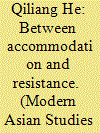

|
|
|
|
|
| Publication |
2014.
|
| Summary/Abstract |
This paper examines the resistance of pingtan storytellers to Communist political domination and economic exploitation on the eve of the Cultural Revolution (1966-1976). In the early and mid-1960s, storytellers rarely mounted resistance through direct confrontations with the political authorities, but often in 'everyday forms' such as by libelling cadres, asking for sick-leave, refusing to conform to the dress code during performances, and threatening to withdraw from troupes. In order to vent their disappointment at the economic hardships following the Great Leap Forward (1958-1961), storytellers resorted to the flexible ways of narrating and performing pingtan stories to manipulate the storylines and characterizations in their stage performances. Hence storytellers engaged in counter-propaganda by telling ribald jokes and distorting stories that were originally designed to praise Communist revolutions. This investigation of the resistance of storytellers, both on and off stage, is intended not merely to raise a long overlooked history of the 1960s from oblivion, but also to highlight the Party-state's inability to ideologically transform Chinese artists prior to the Cultural Revolution.
|
|
|
|
|
|
|
|
|
|
|
|
|
|
|
|
| 2 |
ID:
131805
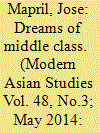

|
|
|
|
|
| Publication |
2014.
|
| Summary/Abstract |
In the past 20 years, Bangladeshi migration to Southern European countries has gained an increasing importance. Portugal is no exception, and today more than 4,500 Bangladeshis live in the country. One of the more interesting facets of this population, though, is their educational and economic profile. They come from what has been roughly summed up as the 'new' Bangladeshi 'middle classes'. Their families are both rural and urban, have properties, and own businesses. Other members of their domestic units work in NGOs, and private and state owned companies. Simultaneously, they have considerable educational backgrounds, with college and university degrees, and most are fluent in English. But what was their motivation to come to Europe in the first place? And what does this tell us about the young Bangladeshi middle class? For these young Bangladeshi adults, it is through geographic mobility that one can earn enough economic capital to access the 'modern' and to progress in the life-course. By remaining in Bangladesh, their access to middle class status and adulthood is not guaranteed and thus migrating to Europe is seen as a possible avenue for achieving such dreams and expectations. The main argument in this paper is that migration-as a resource and a discoursive formation-is itself constitutive of this 'middle class'.
|
|
|
|
|
|
|
|
|
|
|
|
|
|
|
|
| 3 |
ID:
131807


|
|
|
|
|
| Publication |
2014.
|
| Summary/Abstract |
In 1961 the seventh global cholera pandemic, El Tor cholera, broke out in Indonesia. Between 1962 and 1964, El Tor infected the southeast coastal areas of China. This pandemic occurred at a time of significant reorganization for both the rural medical and health systems and the people's communes following the failures of the Great Leap Forward. This paper explores how local governments led rural medical practitioners, health care workers, and villagers to participate in the campaign against the spread of El Tor cholera despite the readjustment and retrenchment of the people's communes as social, administrative, and political units. I argue that, during this period of flux, the local government strengthened its control over rural medical practitioners by institutionalizing their daily work practices and reducing their freedom of movement, whilst simultaneously providing incentives for health care workers to join the vaccination campaign. The people's communes and the household-registration system after 1961 put further restrictions on population mobility. This cellularization of village society greatly facilitated the vaccination, quarantine, and epidemic-reporting processes, and contributed to the formation of an epidemic-prevention system and eventually a response scheme for managing public health emergencies in rural China. This process reflected the complexity of the mutual interactions between the political and medical systems under socialism.
|
|
|
|
|
|
|
|
|
|
|
|
|
|
|
|
| 4 |
ID:
131801


|
|
|
|
|
| Publication |
2014.
|
| Summary/Abstract |
Raihana Tyabji is best known in history, not for her writing or even her singing, but as a devotee of Gandhi. Yet in 1924 this at least nominally Muslim woman composed a small book of bhakti devotionalism that has continued to garner popular interest right into the twenty-first century. She gave it the evocative title, The Heart of a Gopi, on the basis that what had been revealed to her was the very 'soul', the inner self, of the gopi and, through that, an understanding of Lord Krishna himself. This paper considers the question of how far this piece of bhakti devotionalism may be read as a kind of personal narrative, an evocation of the self. Does the referencing of an established narrative tradition give the author's feelings and experiences, especially as a Muslim woman devoted to Krishna at a time of increasing religious rigidity and growing communal strife, a kind of validity not achievable otherwise? And, if so, how do we separate out the author's 'self' from the literary conventions-in this case, the gopi tradition-that structure the story? In the tradition of Islamic life-writing, can the gap between the miraculous and the mundane be breached in order to understand the mystical experience charted here as a kind of autobiography? Even from the rationalist's perspective, should not the life of the imagination still be considered part of the life?
|
|
|
|
|
|
|
|
|
|
|
|
|
|
|
|
| 5 |
ID:
131797
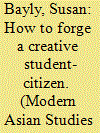

|
|
|
|
|
| Publication |
2014.
|
| Summary/Abstract |
The exaltation of achievement as a measure of collective and individual worth and moral agency has been one of the defining features of Asian developmentalism. Yet in today's age of globalized neoliberal attainment monitoring, the question of who and what an achiever actually is within an achievement-conscious society is far from straightforward or uncomplicated. In Vietnam, the notion of doing well and creditably for self and nation can be deeply problematic for those called upon, either officially or by living and ancestral kin, to embody qualities of attainment and creditable life-course functioning in ways recognizable to those who reward and monitor aspiring achievers. Building on recent fieldwork in Vietnam, this paper explores the ways young Hanoians have engaged with a rapidly changing set of ideas about how the country's tightly regulated schooling and examination system can both unleash and constrain the potential for new and 'creative' forms of attainment on the part of the nation's most promising and productive citizen-achievers.
|
|
|
|
|
|
|
|
|
|
|
|
|
|
|
|
| 6 |
ID:
131800


|
|
|
|
|
| Publication |
2014.
|
| Summary/Abstract |
This paper attempts to revise aspects of the existing interpretations of Nie Hai Hua (A Flower in a Sinful Sea) by applying perspectives from post-colonial studies to the study of this late Qing Chinese novel. Here the novel is read as a national narrative that portrays the emergence of China as a modern nation state from a decaying empire, with its intelligentsia caught between their desire to embrace modernity and nostalgia for cultural traditions. From the mid-nineteenth century to the early twentieth century, traditional Chinese scholars were faced with a predicament: they were lured by the modernity represented by Western learning, on the one hand, but were tied by an emotional link to Chinese tradition, on the other. In a disintegrating society, they struggled both to preserve their own cultural identity and construct a new identity. The opposing groups of Chinese literati portrayed in the novel in fact reflect the schizophrenic state of the Chinese consciousness on the threshold of modernity.
|
|
|
|
|
|
|
|
|
|
|
|
|
|
|
|
| 7 |
ID:
131806
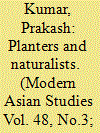

|
|
|
|
|
| Publication |
2014.
|
| Summary/Abstract |
The knowledge of indigo culture that developed on indigo plantations in colonial Bengal was remarkably cosmopolitan in its borrowings. The protean knowledge that was assembled in the first plantations in the Caribbean in the mid-seventeenth century had roots in various peasant traditions on the Indian subcontinent and elsewhere in the world. French naturalists committed this knowledge to texts, making them legible and portable whilst the needs of European empires ensured the perfection of this knowledge on separate continents even as it picked up heterogeneous forms at numerous sites. The heterogeneity of the knowledge attached to the practice of indigo manufacture was reproduced on the Indian subcontinent when indigo was reinvented as a colonial commodity. European planters generously drew on the texts describing indigo-making that were easily available, as the practice of dye making continued to evolve in the colonial locality. Some surviving peasant traditions of indigo culture on the subcontinent also impinged on the evolving knowledge. Thus multiple logics rather than the single colonial logic lay beneath the development of colonial indigo plantations in Bengal. An understanding of the process requires attention to the global genealogies of this knowledge system.
|
|
|
|
|
|
|
|
|
|
|
|
|
|
|
|
| 8 |
ID:
131808
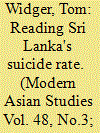

|
|
|
|
|
| Publication |
2014.
|
| Summary/Abstract |
By the final decade of the twentieth century, rates of suicide in Sri Lanka ranked among the highest in the world. However, in 1996 the suicide rate began to fall and was soon at its lowest level in almost 30 years. This decline poses problems for classic sociological theories of suicide and forces us to question some fundamental assumptions underlying social scientific approaches to the suicide rate. Drawing from sociological, medical epidemiological, historical, and anthropological secondary sources as well as 21 months of original ethnographic research into suicide in Sri Lanka, I argue that there are four possible readings of the country's suicide rate. While the first three readings provide windows onto parts of the story, the fourth-a composite view-provides a new way of thinking about suicide, not just in Sri Lanka but also cross-culturally. In so doing the paper poses questions for how the relationship between suicide and society might be imagined.
|
|
|
|
|
|
|
|
|
|
|
|
|
|
|
|
| 9 |
ID:
131804
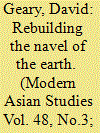

|
|
|
|
|
| Publication |
2014.
|
| Summary/Abstract |
Central to the modern rebirth of Bodh Gaya as the place of Buddha's enlightenment is the growing influence of Buddhist missionaries and transnational religious networks on this pilgrimage landscape in North India. Although this process began in the late nineteenth century, it was not until after India's independence that Buddhism became an integral part of the nation-building project and a key site of post-colonial diplomacy with neighbouring Asian countries. Symbolic of these international and diplomatic ties are the increasing numbers of foreign Buddhist monasteries and temples that have acquired land around Bodh Gaya. This paper seeks to document the historical and transnational religious processes that support the growing globalization of Bodh Gaya and to survey the institutional means through which monasteries have elevated the Buddhist memory of the site. In tracing these different national and regional networks of Buddhism, I argue that there is an underlying tension between Buddhist culture anchored in the national polity and the forces of globalization and religious experience that seek to transcend it.
|
|
|
|
|
|
|
|
|
|
|
|
|
|
|
|
| 10 |
ID:
131803


|
|
|
|
|
| Publication |
2014.
|
| Summary/Abstract |
An enduring question with regard to the voluntary sector is how it can nurture civic engagement and provide public goods. A World Heritage listing for Penang highlights this question by revealing a vibrant civil society network that has made heritage conservation an issue for public discourse and policy agenda. This paper discusses how the marginalized trajectory of Penang is related to the development of its civic realm, social cohesion and local identity, which are sources of Penang's voluntarism. It then examines the engagement pattern of the Penang Heritage Trust, a leading association, which has mounted resistance against the state's failure in heritage provision. This bottom-up approach has preserved Penang's cultural heritage and associated identity, and reveals the distinct nature and capacity of Penang's voluntary sector that goes against the general pattern in Malaysia.
|
|
|
|
|
|
|
|
|
|
|
|
|
|
|
|
| 11 |
ID:
131802


|
|
|
|
|
| Publication |
2014.
|
| Summary/Abstract |
Kanhaiyalal Munshi was a pre-eminent Gujarati author, freedom fighter and politician. A member of the Indian National Congress and a close associate of Mahatma Gandhi, he is credited with having developed and popularized the concept of Gujarat ni asmita, or Gujarati self-consciousness. This paper focusses on a trilogy of Munshi's historical fiction namely Patan Ni Prabhuta (The Glory of Patan) (1916), Gujarat No Nath (The Master of Gujarat) (1917-1918) and Rajadhiraj (The King of Kings) (1922). This paper offers a close reading of these texts, to argue that the trilogy offers the possibility of opening up notions of Gujarati identity, and of showing its constructed nature. Munshi's engagement with the ideas of politics, heroism and nation-building reflects the concerns of a movement that is trying to understand both itself and the nation that it is in the process of imagining. Highlighting the subversion of the texts is an attempt to stretch the boundaries of Gujarati identity, and think differently about the meaning of being Gujarati.
|
|
|
|
|
|
|
|
|
|
|
|
|
|
|
|
|
|
|
|
|